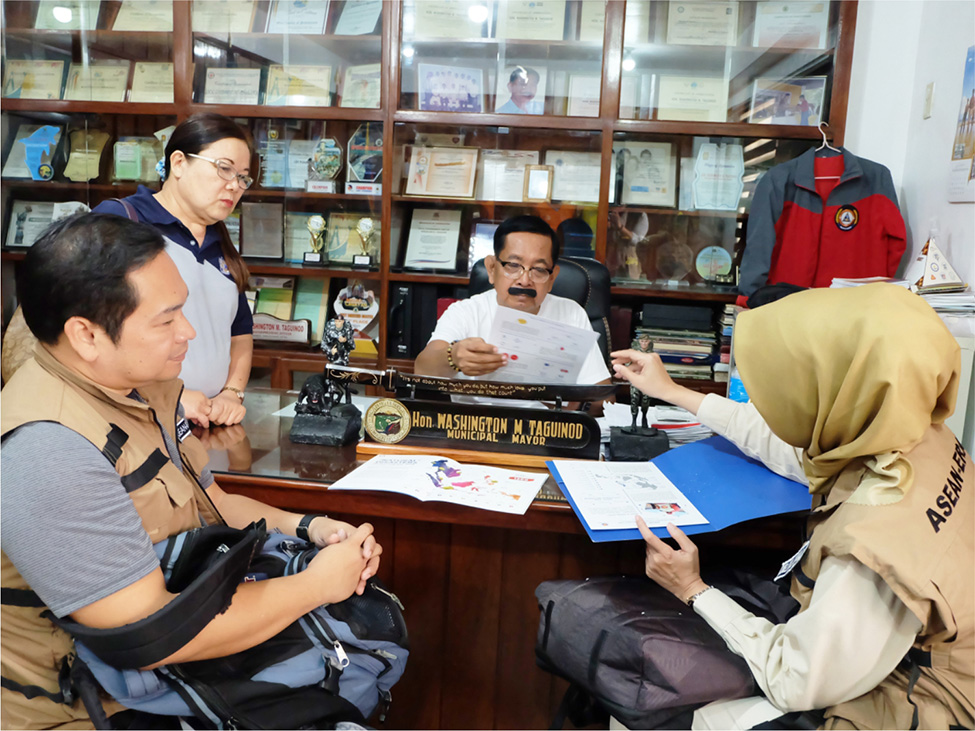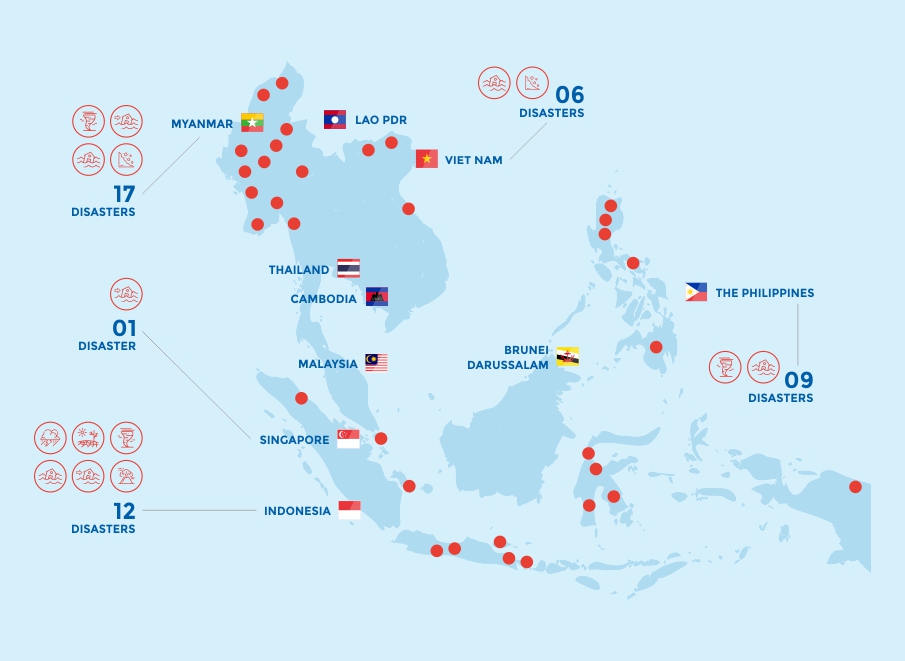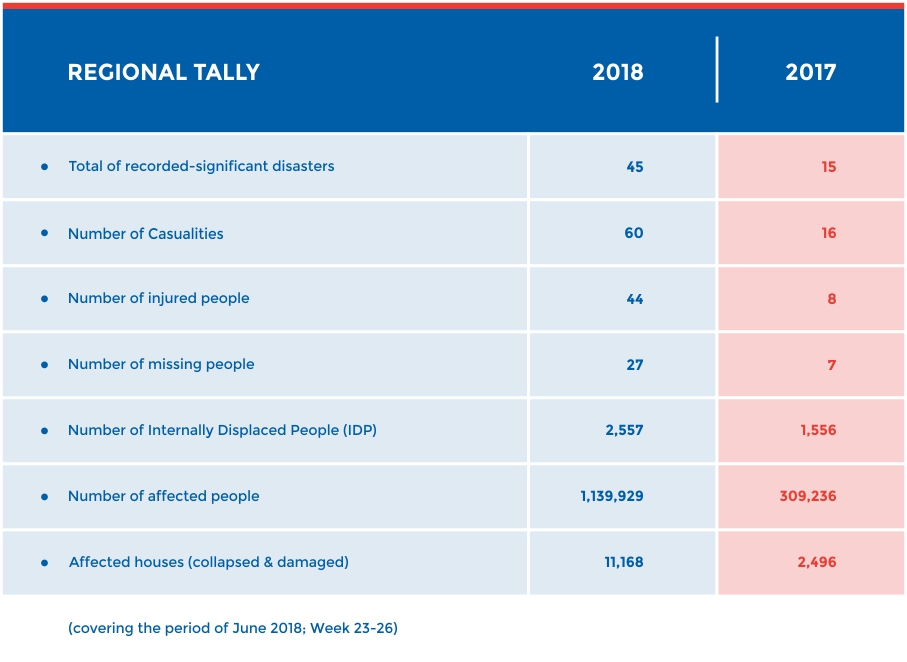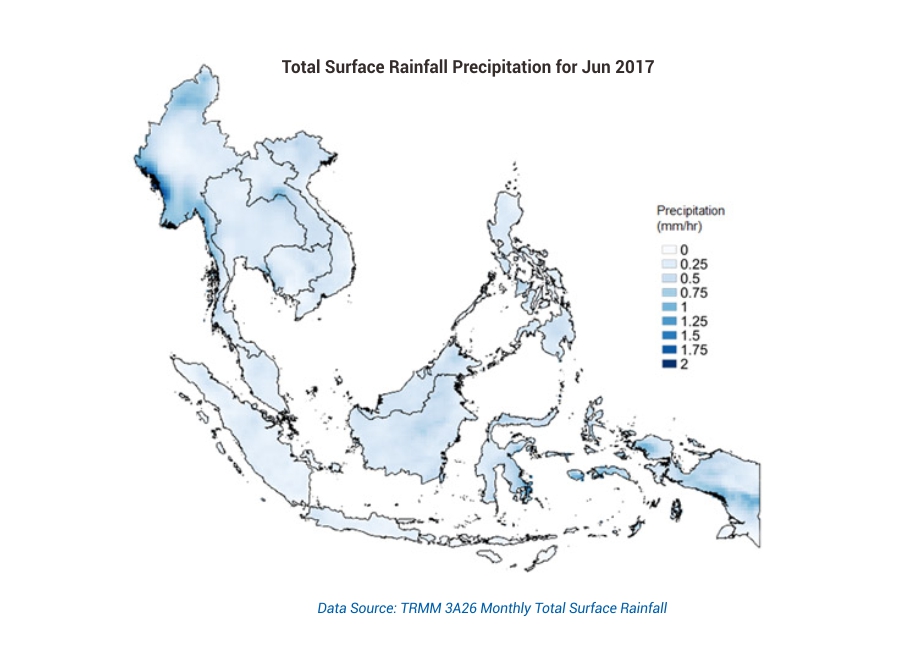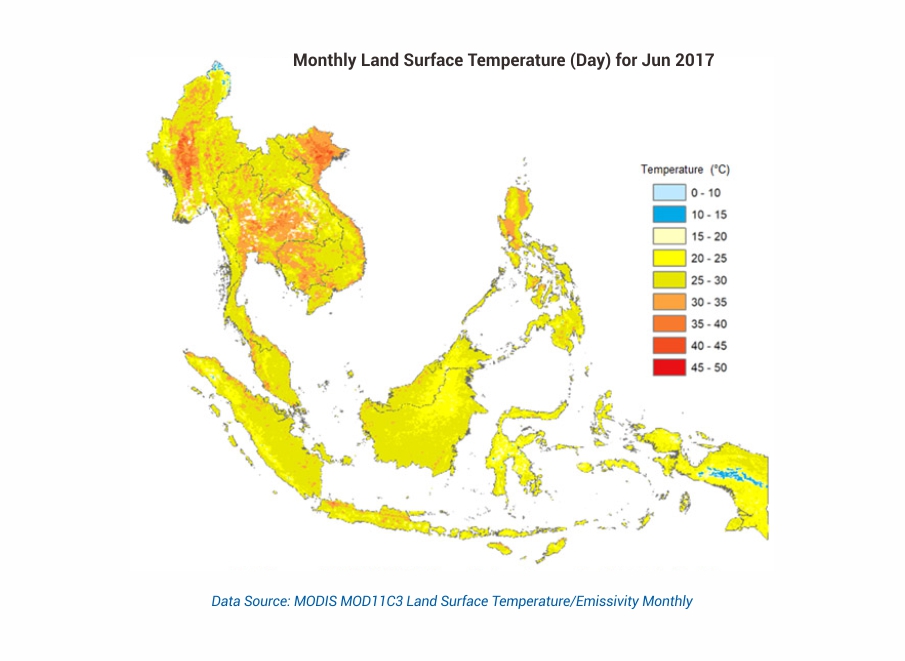Vol 43-ONE ASEAN ONE RESPONSE for Typhoon Mangkhut

ONE ASEAN ONE RESPONSE
FOR TYPHOON MANGKHUT
By mid-September it was all-hands-on-deck in the AHA Centre, with the monitoring team tracking the formation of largest storm cell of the year so far, as it made its way across the Pacific Ocean with a population of millions across the Philippines directly in its path. Communities along the nation’s northern coastline and outer islands were being evacuated, as preparation was well underway for the onset of Super Typhoon Mangkhut (Ompong). On the 15th of September, Typhoon Mangkhut made landfall in Cagayan Province, continuing its path westward with extreme winds and lashing rain, and leaving in its trail over 2.5 million people affected across the Philippines.
Afterwards, a total of 8 provinces and seven cities/municipalities have been announced under state of emergencies, with widespread damage to homes, infrastructure and livelihoods. Typhoon Mangkhut – that had an actual diameter larger than 2013’s Typhoon Haiyan – claimed over 50 lives, with hundreds more injured, and over 180,000 homes either fully or partially damaged. Total damage has been estimated at over USD 6 million, with communities particularly affected by secondary hazards that accompanied the typhoon, such as flooding and landslides. However, was it not for the coordinated effort in the days prior to the storm by the various national and sub-national agencies, alongside communities themselves, loss of life and damage could have been far worse.
“We pre-positioned the Cagayan Valley Response Team in advance, with early evacuation taking place two days prior to the typhoon’s landfall. We also estimated the numbers of people likely to be affected, and provided hygiene kits, non-food items, and generators. These preparedness measures managed to minimise casualties in our region”, explained Mr. Dante Balao, the Regional Director of Office of Civil Defense (OCD) Regional Office II, in Tuguegarao, Cagayan.
Alongside tracking the progress of Typhoon Mangkhut in the weeks and days leading-up to the disaster, the AHA Centre was also engaged with the Philippines Government, through the Philippines’ National Disaster Risk Reduction and Management Council (NDRRMC), in both the preparation and response to the storm. At a later stage, the ASEAN Emergency Response and Assessment Team (ERAT) was mobilised to provide information management and assessment report as the emergency phase coming to an end. On the 15th of September, just hours after the typhoon made landfall, the AHA Centre In-Country Liaison Team arrived in the Philippines, to establish direct communication with the NDRRMC in Manila and in affected areas, and to facilitate ASEAN’s assistance to those in need.
In response to the disaster, the AHA Centre mobilised relief items valued at over USD 275,000 to communities across the affected regions, including 30 tonnes of rice, four generator sets, and 2,000 rolls of tarpaulins. During the handover ceremony on September 24th, Undersecretary Ricardo B. Jalad, the Executive Director of NDRRMC and the Administrator of the Philippines’ Office of Civil Defense showed his appreciation for ASEAN’s support when he stated “I would like to thank and express my deep gratitude to the AHA Centre for facilitating this assistance”.
While Typhoon Mangkhut was a disastrous event for the Philippines and the ASEAN region, it presented an opportunity for the AHA Centre and ASEAN-ERAT to engage on a new element as part of the region’s ongoing efforts to improve disaster management practices. Three ASEAN-ERAT information management specialists were deployed to support the NDRRMC office with data analysis, data visualisation and report writing. One of the ASEAN-ERAT Level 2 members deployed to the Philippines, Adiratna Wira from Malaysia, recognised the importance of information management support for response agencies during disasters. “Aside from the actual products developed, there was great benefit for both the NDRRMC and ASEAN-ERAT members”, said Adiratna. “There was increased understanding in the roles and ways of working for each party, which could speed-up a range of processes and information distribution in the future.”
On the last day of the ASEAN-ERAT’s deployment, Mr. Edgar Posadas, the Director of Operations Service and Spokesperson of the NDRRMC emphasised, “we know that our region is always at risk of disasters, but with neighbours like you and friends like you, we know that things will be moving forward. We are thankful to our ASEAN neighbours and the AHA Centre for your help. The ASEAN region is advancing, we don’t have to go beyond our borders (to respond to disasters), so those beyond the ASEAN corridors can attend to their own disasters. I think it’s a way to go now, everybody is trying to be self-sufficient. We have to be ready should simultaneous disasters are taking place. So, the more capacity that we have and the more prepared we are, the better it will be for the people”.
Written by: Shintya Kurniawan | Photo : AHA Centre
- Published in Highlight
Vol 40-Monthly Disaster Review and Outlook

MONTHLY DISASTER REVIEW AND OUTLOOK
JUNE 2018 | DISASTER MONITORING & ANALYSIS
(DMA) UNIT, AHA CENTRE
GENERAL OVERVIEW OF JUNE 2018
There was a three-fold increase in the number of disasters recorded during June 2018 (45 in total) in comparison to the same time during 2017 (15 disasters). An onset of numerous weather events caused this spike in disasters, with the southwest monsoons, Tropical Depression (TD) Domeng, TD Ewiniar, TD Ester and TS Florita causing floods and landslides throughout the Philippines, Viet Nam and Myanmar. In contrast, several areas south of the equator, particularly Indonesia’s Central Java and Yogyakarta provinces, have experienced the onset of drought conditions, consistent with the shift to the region’s dry season. This such phenomena indicates a similar pattern to 2017, which saw northern parts of ASEAN experiencing wet season floods, while southern parts experienced dry season drought events (see Figure 1) . Overall, 20 flood events, 11 storms and 4 wind-related disasters were recorded throughout June 2018.
In terms of geological hazards, 26 earthquakes registering ≥ M 4.5 were observed across Indonesia and the Philippines. However, only two were strong enough to cause property damage (East Java and Papua provinces of Indonesia, on the 13th and 15th of June respectively. Towards the end of June 2018, concerns were raised due to increased activity reported on Bali’s Mount Agung, which released ash plumes and resulted in a strombolian-type eruption.
OUTLOOK FOR JULY-AUGUST 2018
According to the ASEAN Specialised Meteorological Centre (ASMC), most parts of the ASEAN region will continue to experience wet weather, as the rain band associated with Typhoon Prapiroon affects the region. Hotspot activities have remained subdued, but isolated events have been detected in Viet Nam and Lao PDR. During the first week of July, dry weather is expected to affect Java, and may exacerbate the ongoing drought events. Aside from such southern areas, wet weather is likely to persist over other parts of the ASEAN region. For tropical cyclone (TC) forecasts, the Philippine Atmospheric. Geophysical and Astronomical Services Administration (PAGASA) expects that 10-14 TCs will form and enter the Philippine Area of Responsibility throughout the six months between July and December 2018.
Close and continuous monitoring is still required for Mount Sinabung (Alert Level IV) and Mount Agung (Alert Level III) in Indonesia, particularly due to historic Mount Agung eruptions, which lasted up to one year during 1963-1964.
Written by : Mizan Bisri, Qing Yuan Pang
DISCLAIMER
AHA Centre’s estimation is based on data and information shared by National Disaster Management Organisations (NDMOs) and other relevant agencies from ASEAN Member States, international organisations and news agencies. Further information on each recorded-significant disaster, description and details of data and information are available at: http://adinet.ahacentre.org/reports.
- Published in Monthly Disaster Outlook
Vol 39-Book Review Operationalising One Asean One Response

BOOK REVIEW OPERATIONALISING
ONE ASEAN ONE RESPONSE
Readers of The Column, and those with general knowledge of disaster management in the ASEAN region, should by now be well acquainted with the One ASEAN One Response vision. This vision forms the blueprint for the current and future state of disaster management in ASEAN, driven by the AHA Centre, and strives to develop timely, appropriate and united responses to disaster across the ASEAN region and abroad. One ASEAN One Response is a broad and complex vision, with such breadth and complexity also reflected within its implementation and realisation. Therefore, in early 2018, the AHA Centre developed a book – Operationalising One ASEAN One Response – to form the framework and guidance for the real steps that must be taken to ensure the implementation and realisation of One ASEAN One Response for all stakeholders throughout the ASEAN disaster management sector.
The book begins by tracking back and compiling the context and history of the One ASEAN One Response vision’s development, including the birth of the idea after Typhoon Haiyan, its conceptualisation and promotion, and other steps in its journey until its formalisation through the Declaration on One ASEAN One Response – signed by all ASEAN Member States in 2016. Throughout the early chapters of the book we also learn more about a range of elements, processes and key stakeholders within the One ASEAN One Response movement, allowing for a strong understanding of the mechanisms and parties central to the vision’s real implementation.
With a sound understanding and picture of the One ASEAN One Response context and history, the book then turns to the all-important operationalisation of the vision, capturing the processes, mechanisms and measurements that guide the realisation of a collective regional response for all members of the ASEAN community. The overall goal of One ASEAN One Response is the umbrella under which the operationalisation takes place – namely to increase speed of disaster response, provide to-scale resources for preparedness and response, and do so in solidarity as a strong, united ASEAN region with the common objective of responding to the needs of those affected by disaster. With such a goal identified, the book then identifies the seven key principles of One ASEAN One Response, which ensure that ASEAN responds through singular mechanisms including:
1. ONE POLICY FRAMEWORK – AADMER
2. ONE SOP – SASOP
3. ONE RESPONSE PLAN – AJDRP
4. ONE POLICY BODY – ACDM
5. ONE POINT OF CONTACT – NDMOs
6. ONE REGIONAL COORDINATING AGENCY – AHA Centre
7. ONE FIELD COORDINATION CENTRE – JOCCA
The book then moves on to providing answers regarding key elements of One ASEAN One Response operationalisation, covering nine specific elements that form the entire cycle of disaster management in the ASEAN region. These elements are made up of:
1. Policy guidance
2. Coordination mechanism
3. ASEAN-ERAT
4. Information management
5. Operating procedures
6. Response plan
7. Standby assets and capacities
8. Participating actors
9. Exercises and after-action reviews
Finally, the book concludes with an overall roadmap of One ASEAN One Response implementation, including progress indicators that can be used to measure the implementation stages of the vision. Overall, the implementation has four key phases – namely ASEAN 1.0, ASEAN 2.0, ASEAN 3.0 and ASEAN X.0. As highlighted within this roadmap, at time of printing the One ASEAN One Response has already reached, and is working its way through ASEAN 2.0. As the implementation continues, ASEAN 3.0 should see the region able to successfully engage East Asia Summit participating countries within all aspects of response mobilisation, and further into the future, ASEAN X.0 would see ASEAN capable of engaging in responses outside of the ASEAN region itself.
Written by : William Shea | Photo : AHA Centre
- Published in Insight






